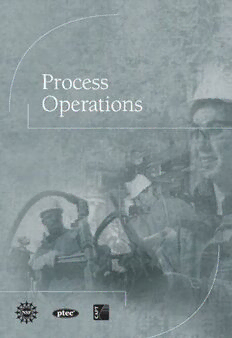Table Of ContentThis page intentionally left blank
Process oPerations
Process oPerations
Editorial Director: Vern Anthony
Acquisitions Editor: David Ploskonka
Editorial Assistant: Nancy Kesterson
Director of Marketing: David Gesell
Executive Marketing Manager: Derril Trakalo
Senior Marketing Coordinator: Alicia Wozniak
Senior Marketing Assistant: Les Roberts
Production Manager: Holly Shufeldt
Art Director: Jayne Conte
Cover Designer: Karen Noferi
Cover Art: Center for the Advancement of Process Technology
Full-Service Project Management and Composition: Integra
Printer/Binder: Edwards Brothers
Cover Printer: Lehigh-Phoenix Color
Copyright © 2012 Pearson Education, Inc., publishing as Pearson Prentice Hall, One Lake Street, Upper Saddle
River, NJ 07458. All rights reserved. Manufactured in the United States of America. This publication is protected by
Copyright, and permission should be obtained from the publisher prior to any prohibited reproduction, storage in
a retrieval system, or transmission in any form or by any means, electronic, mechanical, photocopying, recording, or
likewise. To obtain permission(s) to use material from this work, please submit a written request to Pearson Education,
Inc., Permissions Department, Pearson Prentice Hall, One Lake Street, Upper Saddle River, NJ 07458.
Many of the designations by manufacturers and seller to distinguish their products are claimed as trademarks. Where
those designations appear in this book, and the publisher was aware of a trademark claim, the designations have been
printed in initial caps or all caps.
Library of Congress Cataloging-in-Publication Data
Process operations / Center for the Advancement of Process Technology.
p. cm.
Includes index.
ISBN-13: 978-0-13-700410-2
ISBN-10: 0-13-700410-9
1. Technical education—Study and teaching—United States. 2. Industrial arts—
Study and teaching—United States. 3. Technical education—Curricula—United States.
4. Chemical processes—Handbooks, manuals, etc. I. Center for the Advancement of Process Technology
T73.P664 2012
660—dc23
2011018292
10 9 8 7 6 5 4 3 2 1
ISBN 10: 0-13-700410-9
ISBN 13: 978-0-13-700410-2
Process oPerations
Process oPerations
Center for the Advancement of Process Technology
Boston Columbus Indianapolis New York San Francisco Upper Saddle River
Amsterdam Cape Town Dubai London Madrid Milan Munich Paris Montreal Toronto
Delhi Mexico City Sao Paulo Sydney Hong Kong Seoul Singapore Taipei Tokyo
This page intentionally left blank
contents
contents
Preface xi
Acknowledgements xiii
Industry Content Developers and Reviewers xiii
Education Content Developers and Reviewers xiv
Center for the Advancement of Process Technology Staff xv
Chapter 1 Introduction to Operations 1
Objectives 1
Key Terms 2
Introduction 2
Equipment Review 3
Systems Review 4
Instrumentation Review 5
Operations Organizational Structure 6
The Process Technicians’ Roles and Responsibilities 7
The Process Technician of the Future 9
Summary 9
Checking Your Knowledge 9
Activities 10
Chapter 2 Procedure Writing 11
Objectives 11
Key Terms 12
Introduction 12
Procedure Writing Principles and Techniques 12
Techniques for Effective Written Communication 16
Summary 23
Checking Your Knowledge 24
Activity 25
Chapter 3 Reading Process Drawings 27
Objectives 27
Key Terms 28
Introduction 29
Uses for Common Process Drawings 29
Process Drawing Information 37
Symbols 41
Equipment Standards 49
v
vi Contents
Summary 50
Checking Your Knowledge 51
Activities 52
Chapter 4 Complying with, Safety, Health, and Environmental Policies 53
Objectives 53
Key Terms 54
Introduction 54
Safety, Health, and Environmental Policies 55
The Process Technician’s Role in Safety, Health, and Environmental Policies 57
Safety Equipment 61
Environmental Hazards 64
Potential Hazards 65
Isolation Scenario 66
Routine Maintenance and Inspection 66
Summary 67
Checking Your Knowledge 67
Activities 68
Chapter 5 Communication: Verbal, Nonverbal, and Written 69
Objectives 69
Key Terms 70
Introduction 70
Verbal Communication 71
Written Communication 72
Nonverbal Communication (NVC) 73
Electronic Communication Devices 73
Communication during Start-Ups or Shutdowns 78
Communication during Routine Maintenance 79
Summary 80
Checking Your Knowledge 80
Activities 81
Chapter 6 Shift Change/Relief 83
Objectives 83
Key Terms 84
Introduction 84
Shift Change/Relief 84
Methods Used to Make Relief 85
Participants in the Shift Change 88
Making a Timely Relief 88
Establishing Good Relationships 90
Summary 90
Checking Your Knowledge 90
Activities 91
Chapter 7 Abnormal and Emergency Operations 92
Objectives 92
Key Terms 93
Contents vii
Introduction 93
Abnormal Operations 94
Emergency Operations 95
The Process Technician’s Role in Abnormal Operations 96
The Process Technician’s Role in Emergency Operations 97
Potential Hazards 99
Technician Emergency Response Duties 99
Summary 104
Checking Your Knowledge 104
Activities 105
Chapter 8 On-the-Job Training 106
Objectives 106
Key Terms 107
Introduction 107
Purpose and Importance of On-the-Job Training 107
Training Methods, Skill Development, and Observing the Trainee 108
Training Materials 110
Summary 113
Checking Your Knowledge 114
Activities 115
Chapter 9 Maintenance 116
Objectives 116
Key Terms 117
Introduction 117
Routine Maintenance 118
Predictive Maintenance 118
Reactive Maintenance 119
Preventive Maintenance 119
The Process Technician’s Role in Maintenance 120
Lubrication 124
Lubricant Storage, Handling, and Disposal 125
The Process Technician’s Role in Lubrication 127
Turnarounds and Turnaround Maintenance 128
The Process Technician’s Role in Turnarounds 130
Shutdowns and Start-Ups 133
Summary 134
Checking Your Knowledge 134
Activities 135
Chapter 10 Unit Commissioning 137
Objectives 137
Key Terms 138
Introduction 138
Unit Commissioning 138
Summary 143
Checking Your Knowledge 144
Activities 145
viii Contents
Chapter 11 Unit Start-Up 146
Objectives 146
Key Terms 147
Introduction 147
Normal/Routine Start-Up 148
Start-Up after an Emergency Shutdown 149
Equipment Start-Up after Maintenance Activities 150
Unit Start-Up 151
The Process Technician’s Role in Planning and Executing Start-Ups 152
Potential Hazards 155
Summary 156
Checking Your Knowledge 156
Activity 157
Chapter 12 Lock-Out/Tag-Out 158
Objectives 158
Key Terms 159
Introduction 159
Lock-Out/Tag-Out 160
Lock-Out and Isolating Devices 162
Types of Energy Requiring Isolation 167
Removing Lock-Out/Tag-Out Devices 167
Summary 168
Checking Your Knowledge 168
Activities 169
Reference 169
Chapter 13 Utility and Auxiliary Systems 170
Objectives 170
Key Terms 171
Introduction 171
Steam Generation and Distribution 171
Water Systems 176
Firewater 178
Potable Water 179
Sanitary Sewer System 180
Wastewater 182
Refrigeration Systems 183
Cooling Towers 185
Electricity 187
Air Systems 189
Pressure Relief and Flare System 190
Nitrogen 192
Natural Gas 193
Summary 193
Checking Your Knowledge 194
Activities 194

